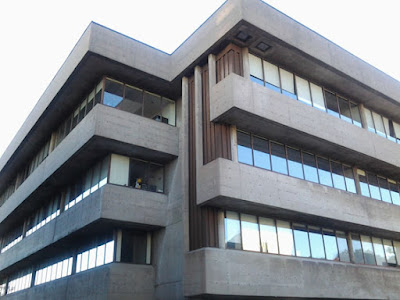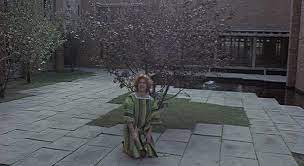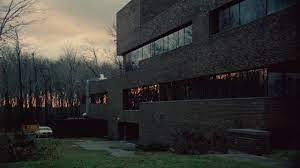Appendix 1: Architectural Space(s) in Cronenberg’s Early works
Few other directors have used architecture as a character as well as Cronenberg. Kubrick comes to mind most readily, particularly in the early works where the ironic distance of the characters is buttressed by the choice of antiseptic or Brutalist architecture used as settings.
It is palpable, almost out of the gate with “Stereo” where the telepaths move through a sterile environment pursuing the ability to connect emotionally and sexually. It is as if Cronenberg is daring the scientific community to look at how contradictory it is to attempt to distance the observer from the observed through the play-acting of lab coats and “laboratory conditions.” This is a conceit he would revisit periodically throughout his work; but it is impressive how well he used it even this early on.
“Stereo” and “Crimes of the Future” both traffic in this idea of spaces set aside for scientific purposes (as opposed to “artistic” spaces - which we’ll encounter in “Scanners”) and how the spaces both reflect and guide/restrict both communication and understanding.
From “Stereo”
 |
| This is the building where Cronenberg shot “Stereo”. It’s a fine example of what was considered futuristic architecture at the time and a striking example of Bruatlism that sought to reduce architecture to its essence. Favored by authoritarian and fascist governments for its allegedly utilitarian function, Brutalism may be the finest example of what happens when a society attempts to remove aesthetics from functionality. Such architecture sets up its own space and doesn’t work in any context but its own. |


 |
In all three of the above examples, we encounter the contradiction of a space designed for “objectivity” (or maybe even Randian Objectivism) where its purpose in the film is to explore subjective states and promote interpersonal/intersubjective communication. The last still exemplifies the contradiction of two sets of characters facing one another through a transparent medium but nonetheless separated from each other.
Even this early on, Cronenberg renders the space between inside and outside suspect.
|
From “Crimes of the Future”




 |
In “Crimes of the Future”, there is more of a breakdown in architectural and societal functioning. Women have all but vanished from society and the men that are left behind are confused, dysphoric, and degenerate. The spaces they inhabit are still more formalist and quasi-Bauhaus influenced but read as failures of masculine space both as environments and as psychic interiors.
From “Shivers”
In “Shivers”, the action takes place predominantly in the Starliner Highrise. It does have one specific “scientific” set, but for the most part, we see the ironic casting of modern architecture as a container for the unruly emotional eruptions that humans are themselves containers for. The building itself is rather Ballardian, but the interior points up both how dark and labyrinthian our psychic interiors are, as well. By the time we’re well into the film, the various transgressive parties/orgies/couplings, etc. echo something of the violence of what happens in our digestive tracks.
From “Rabid”

 |
The Keloid Clinic in “Rabid” is the womb where Rose as patient zero is birthed. Again, in keeping with Cronenberg’s theme of scientific obsession and murky motivations gone awry, it is an ostensibly strong building, fortified against the “outside” world while protecting/obscuring/hiding the “inside” chaos under the guise of scientific order. |
|
From “The Brood”
From “Scanners”
 |
Consec: where the program that gave rise to the Scanners began. Unlike the other spaces, there is little duplicitousness in what goes on in the program; we know that these are weaponized psychic post-humans. |



 |
In “Scanners”, the spaces open up more into the greater community but the choices of environments still seem to insinuate an ambiguous present as opposed to a probable/possible future. They actually do seem to act as vessels for the violence that unfolds. The conference room is also a call-back to a similar chamber and functions in “Stereo” and even the mall and subway are less areas for commerce and conveyance than for impending psychic disruption that will begin rippling through the world unless or until it can be checked. As a kind of thought game, a sequel to “Scanners” could well give rise to that X-Men scenario that I mentioned in the main essay.
Appendix Two: The Body as Betrayal, the Body as Weapon; and the Mind? An emergent property of the body, or just another organ?
From “Stereo”
|
 |
| I wanted to include this one still from “Stereo” because of the almost arthropodic mimesis of the table: with the man at the head of the table and the chair seats and back dark enough and in contrast to the highlighted arms, the whole gestalt resembles a beetle or a bug, perhaps upside down on its back. This says much more about me than acting as a choice of Cronenberg’s but it almost feels like a presentment of other insectoid forms to come. |
From “Shivers”
 |
The first fatality. “Shivers” takes off with a remarkable failure of a modified venereal disease that is transmitted by wriggling phallic parasites that work their hosts into psychotic/sexual frenzies. While Cronenberg’s first short films began to introduce these themes, the execution grew more sophisticated. The stop action animation of the tendrils in “From the Drain” give way to puppetry of the creatures in “Shivers” and “Rabid”. The telepathic effects explored in “Stereo” are rendered explicit and graphic by the time we get to “Scanners”. From “Shivers”, there is a kind of throughline to “The Brood”, as well, as Rose’s externalized rage mirrors or echoes the externalization of both the psychosexual parasites in “Shivers” and the stingers that emerge from Marilyn Chambers’ armpits.
 | |
We learned in “From the Drain” that no good comes from taking a bath.

 |
The orgiastic frenzies in “Shivers” are tame by modern standards, but in the context of the times, we can see how shocking they must have been. The beats of the editing, even in these early films, are expert. There are no gratuitous “jump scares”, and rarely are there musical cues to signal something coming. Besides, if anything, the violence in Cronenberg is not glorified nor glamorous. The grotesqueries even in these early features are tactile and organic, supporting the various theses of the narratives.
From “Rabid”

The red phallus emerges from a vaginal opening in Rose’s armpit and from that comes a sharp blade/toothlike proboscis that injects fatal rage and madness in her victims. One could spend a lot of time deconstructing and examining the signifiers of all of these devices, but to what end? Much of the criticism leveled at Cronenberg even in these early films there is a degree of misogyny, if not almost an almost nihilistic sensibility. I believe both are wrong. Even in “The Brood”, Cronenberg is interrogating the twists of gender identity and the fluidity of sexual expression. In all these cases, the emotional ugliness is unleashed less through malevolence than through ignorance and arrogance. Cronenberg has taken the cliché of man should not play God in a fresh and ever new direction. The difference between, say, the Frankenstein movies of Universal in the thirties and the works of the Canadian filmmaker forty or so years later, is that beyond the technical advances in cinema, there is the shift across the board of sociological and historical changes was vast. The shift in sexual “mores”, the sexual revolution of the late sixties, opened up new vistas, views and approaches to how sexual elements, sexuality, and ideas of gender boundaries was portrayed across cinema. I don’t believe Cronenberg’s approach is so easy to dissect or interpret. Nevertheless, these early uses of transgressive and often conflicting signals are open to virtually any number of interpretations.
Since much of the interpretation of the films resides in the main article, the remaining pictures will be presented with minimal commentary.
From “The Brood”
|



Do refer to the commentary on “The Brood” for details.
|
|
From “Scanners”
The body modifications in “Scanners” are far more subtle than might be anticipated, but the effects have grown more sophisticated.
And of course, there is the exploding head sequence that was an early cinematic cause célèbre for its shock factor.





































Comments
Post a Comment